Makes one 9” cheesecake about 2” high
This cheesecake is the simplest I’ve ever found, and the base of several other fun variants that include different cheeses, including marscapone and brie, or other fats like sour cream and butter. By itself it’s smooth and creamy, plain and simple, cheesy and not very sweet, and a great vehicle for toppings such as fresh fruit, stewed fruit syrups, or chocolate drizzles of various bitterness. This recipe generally came from Nick Malgieri’s How to Bake.
Although I tried to be manly and machine-independent when I was in college (mostly because I didn’t have a KitchenAid™), the best way to make this simple cheesecake is with a stand mixer because you can really whip the cream cheese without killing your arm muscles or breaking a wooden spoon or two, both of which I’ve done.
Cheesecakes are almost always cooked in a springform pan, a 9” round pan with sides that you can unbuckle to remove without disturbing the cooked cake sitting on the base. I strongly prefer glass bases with no edges, so a cake server can pull a piece off without running into a metal lip on the base.
Warm the filling ingredients
Set out the filling ingredients to sit at room temperature for a bit:
2 lbs plain cream cheese
1 cup sugar
4 eggs
vanilla extract
While those ingredients are warming up (you don’t want to try beating 34°F cream cheese), you can prepare and bake the crust. Crust is always a personal preference, but here’s a simple egg-flour crust that works well. Use either the stand mixer with a second bowl, or a medium mixing bowl.
Making the crust
Mix well in a mixing bowl:
1 cup sugar
1 egg yolk
½ tsp vanilla extract
Measure out in a small mixing bowl:
Fold the flour mixture into the sugar mixture and mix until blended, but no longer, to prevent glutenizing the flour. Pour into the very well buttered springform pan and use your clean, buttered fingers to spread around and squish into the edges of the pan, angling slightly up the side to get a bit higher crust on the edges (does this help with holding a slice together? or is it just personal preference?)
Bake at 350°F for 12min or until a light golden brown. Place on a cooling rack so it’s not hot once you’re ready to pour in the filling.
Making the filling
Add the first 8oz box of cream cheese (or roughly 1/4 of the total if not using 8oz boxes) to the stand mixer and turn on to low speed. Mix until mostly broken up and add the remaining boxes one at a time as each breaks up. Pause to scrape the sides and bottom of the mixing bowl with a rubber spatula. Turn on the mixer to medium speed and gently whip the cream cheese until it’s light and smooth, about � minutes.
Add the sugar, and then do the same: after mixed, pause and scrape the sides and bottom of the bowl with a rubber spatula.
For each egg, do the same: add the egg, mix on slow speed just until incorporated, then pause to scrape the sides and bottom of the mixing bowl. These steps help ensure that no lumps of thick cream cheese remain in the finished cake, and it’s worth taking the time to do so.
Finally, add the vanilla, then mix just until it disappears. Pour into the cooled pie crust. Prepare to cook in a water bath if possible, to prevent burning or otherwise overcooking the crust. Cook in the water bath in a 350°F oven for 50-70min, until the only the center of the cake jiggles when jostled. If the top begins to brown more than your liking before the cake is fully set, cover with tinfoil for the last 20min or so to stop the browning.
Preparing a water bath
What you’ll need:
a deep cookie sheet or other pan wider than your springform with almost 1” deep sides
extra wide / heavy-duty tinfoil (most tinfoil isn’t much wider than the 9” pan, but you can use two perpendicular regular pieces if needed)
hot / boiled water
Place the ready-to-be-baked cheesecake in its springform pan in the center of the tinfoil and wrap up the tinfoil edges to the top of the pan (but not over the edge of the pan). Place the tinfoiled pan onto the cookie sheet, shove into the oven, and then pour about an inch of hot or just boiled water into the cookie sheet. Bake according the above.
Why a water bath?
A water bath is a way of preventing the crust from getting any hotter than the water, which by definition remains below 212°F (at sea level). This helps prevent the crust from overcooking and burning. The water will boil off before getting any hotter than 212°F, and because there’s so much water, it would take several hours to do so, longer than the baking time of a cheesecake. An anecdotal secondary benefit is that it also helps keep the inside of the oven a bit more humid & the cake more moist, although I’m not aware of science experiments that have proven this. Just be sure that the water never gets any higher than the tinfoil, otherwise you’re going to get a soggy crust.
